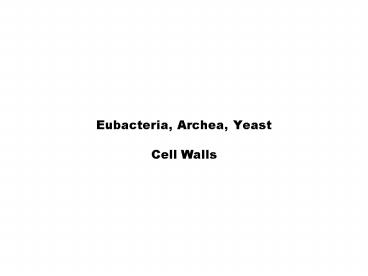Eubacteria, Archea, Yeast Cell Walls - PowerPoint PPT Presentation
1 / 29
Title:
Eubacteria, Archea, Yeast Cell Walls
Description:
Eubacteria, Archea, Yeast Cell Walls – PowerPoint PPT presentation
Number of Views:269
Avg rating:3.0/5.0
Title: Eubacteria, Archea, Yeast Cell Walls
1
Eubacteria, Archea, YeastCell Walls
2
Question
- Plants, bacteria, and yeast all have cell walls
that provide resistance to osmotic
pressure. Compare the composition and
architecture of these barriers.
3
(No Transcript)
4
(No Transcript)
5
(No Transcript)
6
Schaffer et al (2001) Proteomics 1248
7
Peptidoglycan
8
(No Transcript)
9
(No Transcript)
10
Gram-positive Teichoic Acids
11
LPS - Lipid A
Compare the structure of LPS to glycerolipids and
gangliosides.
12
(No Transcript)
13
O-antigens
- O-antigens consist of 2-8 sugars, repeated 50
times - O-antigens gives rise to different serotypes and
some are correlated with disease
14
(No Transcript)
15
Capsule type
Structure
K1, polysialic acid
K5, N-acetylheparosan
Group A Streptococcus (hyaluronan)
- Mucoid strains contain a polysaccharide capsule
- 80 different capsules types are known just in E.
coli - Extraordinary diversity of structure
16
Yeast Cell Wall
The cell wall is made of 60 b-glucans, 40
mannoproteins, and 1 chitin
17
(No Transcript)
18
Compare and contrast the pathways of glycoprotein
N-glycosylation in Archaea ,yeast and mammals.
What is the functional significance of the
differences?
19
Fig. 21.5
20
(No Transcript)
21
N-linked glycans Isoprenoid donors Acidic
glycans Crosslinking
Burda Aebi (1999) Biochim Biophys Acta 1426239
22
Summary
- Bacterial cell walls are complex layered
structures composed of multiple classes of
glycans - Bacterial wall glycans provide an exoskeleton,
define shape, protect against turgor pressure,
create antigenic serotypes, and provide a way to
prevent immune recognition - Glycosylated proteins are present in eubacteria
and in archaea - Yeast produce many of the same glycans found in
higher eukaryotes, but the mecahnism of assembly
differs in subtle way - Yeast cell walls are composed of glucans,
mannans, chitin) - Yeast and bacteria provide powerful genetic
systems for understanding membrane and cell wall
assembly
23
Questions
- 1. The relationship of commensal bacteria in the
gut is sometimes described as symbiotic.
Describe the system that exists between
Bacteroides and the mouse host and and how its
mutually beneficial.
24
Ileum and fucose
UEA1 P28 Ileum
OPA ?1-6
UEA1 ?1-2
UEA1 P25 Germ-free
UEA1 P25 Conventional
25
Induced Fucosylation
26
Fucose Operon
27
Fu-4 Mutant Cant Metabolize Fucose
28
(No Transcript)
29
(No Transcript)































